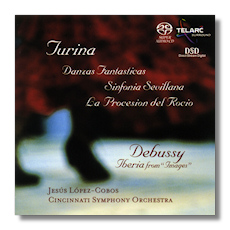
The Internet's Premier Classical Music Source
Related Links
- Latest Reviews
- More Reviews
-
By Composer
-
Collections
DVD & Blu-ray
Books
Concert Reviews
Articles/Interviews
Software
Audio
Search Amazon
Recommended Links
Site News
 CD Review
CD Review
Danzas fantásticas

- Joaquín Turina:
- Danzas fantásticas
- Sinfonia Sevillana
- La Procesión del Rocio
- Claude Debussy: Ibéria
Cincinnati Symphony Orchestra/Jesús López-Cobos
Telarc CD-80574 DDD 64:24
Also released on Hybrid Multichannel SACD SACD-60574
Amazon
- UK
- Germany
- Canada
- France
- Japan
- ArkivMusic
- CD Universe
Jesús López-Cobos has been Music Director of the Cincinnati Symphony Orchestra since 1986. With this recording, he brings his long tenure to an end. As with this disc's immediate predecessor (Shostakovich's First and Fifteenth Symphonies, Telarc CD-80572), the conductor and his orchestra score a bull's-eye with performances that are clean but not clinical, and engaging but not hyped.
Turina was born in Seville in 1882, so he is "the real thing." Debussy, on the other hand, barely set foot in Spain, yet Ibéria convinced even Manuel de Falla: "the entire piece down to the smallest detail makes one feel the character of Spain," he wrote. Nevertheless, Turina and Debussy were not particularly close, stylistically, although both were Impressionists to a greater or lesser degree. Debussy was a composer who internalized his emotions, whereas Turina was more comfortable with expressing them directly. Realizing this is what makes the difference between a successful, complementary CD and just an odd juxtaposition of works by Debussy and Turina.
"Everybody" has recorded Debussy's Ibéria – López-Cobos's reading is fine and cultivated – but the Turina works still are relatively uncommon. Danzas fantásticas (1920) has its Ravel-like overtones (including moments of near phantasmagoria), but essentially it is a civilized, colorful work that keeps its dark Spanish eyes straight ahead. López-Cobos chooses to emphasize its refinement, even in the finale, which is marked "Orgía" (Revel).
The Sinfonia Sevillana, completed shortly after the Danzas fantásticas, is less impressionistic, more a set of three picture postcards than the collection of intangible feelings suggested by the earlier work. Respighi's three Rome-influenced tone poems are points of reference. The middle movement features a melting English horn solo – much warmer than anything in Sibelius's Swan of Tuonela! As in the other works, López-Cobos conducts with skill and sensitivity. His flair, if you will, is creating a transparent and ideally balanced orchestral sound. (Telarc's DSD – Direct Stream Digital – recording technique definitely makes López-Cobos's job easier.)
The CD closes with La Procesión del Rocio, an early work depicting the procession, half civil and half religious, that takes place in Seville every June in honor of the Virgin Mary. It is as colorful as the other two Turina works on this CD, but more loosely constructed, mostly because of the juxtaposition of the sacred with the worldly. López-Cobos conducts it suavely, and the Cincinnati Symphony Orchestra makes a first-class sound.
This disc brings an excellent series of recordings to an end worthy of that which preceded it.
Copyright © 2002, Ray Tuttle





















